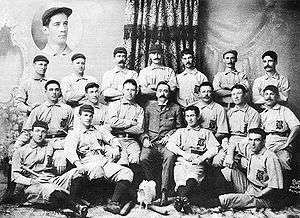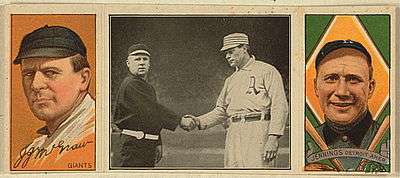Baltimore Orioles (1882–1899)
The Baltimore Orioles were a 19th-century American Association and later National League of Professional Base Ball Clubs ("National League" - organized 1876) baseball team from 1882 to 1899. The early ball club, which featured numerous future Hall of Famers, finished in first place three consecutive years (1894–1895–1896) and won the "Temple Cup" national championship series in 1896 and 1897. Despite their success, the dominant Orioles were contracted out of the League after the 1899 season, when the N.L. reduced its number of teams and franchises from 12 to 8, with a list of teams and cities limited to just the northeastern United States which endured for the next half-century until 1952 (in the N.L.) and 1954 (in the A.L.). No franchises were located any further west than St. Louis and no further south than Washington, D.C.. This controversial action resulting in the elevation of the former minor league level Western League of Professional Baseball Clubs ("Western League", 1885-1899) by leaders such as Ban Johnson (1864-1931), into a newly reorganized, upgraded American League of Professional Base Ball Clubs ("American League") in 1900, and declaring itself a "major league" beginning play during the 1901 season of which the new reorganized Baltimore Orioles were a prominent charter member for its first two seasons which "waged war" on the elder "Nationals".
| Baltimore Orioles | |
|---|---|
 | |
| Years 1882 – 1899 | |
| Based in Baltimore, Maryland | |
| Major league affiliations | |
| |
| Ballpark | |
| |
| Team colors | |
|
Orange/yellow/gold, black, white | |
| Owners | |
| Managers | |
| |
| Major league titles | |
The new "Birds" played at American League Park (also known as the second "Oriole Park") located 8 city blocks further north along Greenmount Avenue at the southwest corner of 28th Street, in Waverly.
History
The team (formally the "Baltimore Base Ball and Exhibition Company"[1]) was founded in 1882 as a charter member of the American Association, which was then a major league. After several years of mediocrity, the team dropped out of the league in 1889, but re-joined in 1890 to replace the last-place Brooklyn Gladiators club which had dropped out during the season. After the Association folded, the Orioles joined the National League in 1892. The beginnings of what was to become a legendary team can be traced to June 1892, when Harry Von der Horst hired Ned Hanlon to manage the Orioles, giving him stock in the team and full authority over baseball operations. Ned moved his growing family to a house that stood a block away from Union Park.
After two years finishing near the bottom of the league, the Orioles won three consecutive pennants with several future Hall of Famers under player/manager Ned Hanlon from 1894 to 1896. They followed up the title run with two consecutive second-place finishes. Accordingly, they participated in all four editions of the Temple Cup series, winning the final two in 1896 and 1897. After the team's 1898 second-place finish, Hanlon and most of the team's stars (though not John McGraw or Wilbert Robinson) were moved across to the Brooklyn Dodgers of the National League by the joint ownership of the clubs.
Following a fourth-place finish in 1899, the National League eliminated four teams from the circuit, the Orioles among them. First-year player/manager John McGraw followed through on his threats to abandon the NL and form a club in the rival American League (being formed by new president Ban Johnson out of the former minor Western League), doing so beginning in 1901. (Those newly formed A.L. Orioles only stayed in Baltimore for two seasons before being moved to New York as "the price of peace" as agreement was established in 1903 between the older circuit and its new upstart rival allowing the "Americans" to have a representative also in the "Big Apple" as a sign of respectability. The old Oriole franchise under McGraw became known as the "New York Highlanders" or occasionally the "New York Americans", later becoming renamed in 1913 as the New York Yankees.)
A high-minor league franchise in the old Eastern League filled the void left by the Orioles in 1903, including local product and future baseball icon Babe Ruth and Lefty Grove, even winning an unbroken string of six straight titles, 1919–1925 in the "Triple A" (AAA) level of minor league baseball in the reorganized International League (after 1911); but top-level professional baseball would not return to Baltimore until the St. Louis Browns relocated to the City in 1954.
Ballpark
The Orioles played briefly at the old Oriole Park, in Harwood, south of the Waverly neighborhood at 29th and Barclay Streets, (just a block west from Greenmount Avenue) from 1890 to 1891. (The 1901 AL Orioles-turned-Highlanders would play at the site a decade later.) During the 1891 season, the Orioles moved a few blocks away to Union Park on Huntington Avenue (later renamed 25th Street) and Greenmount Avenue, where they would play and win their famous three straight championships for the old "Temple Cup" in 1894–1895-1896. Unfortunately they were removed from the N.L. roster after the 1899 season when the League was controversially reduced from 12 team franchises to 8, which endured for the next half-century. For further info see List of baseball parks in Baltimore, Maryland.
Stars

The original Orioles were one of the most storied teams in the history of the game. Managed by Ned Hanlon, they won NL pennants in 1894, 1895 and 1896, and sported some of the most colorful players in history including John McGraw, Wee Willie Keeler, Hughie Jennings, Joe Kelley, Wilbert Robinson, and Dan Brouthers.
They were rough characters who practically invented "scientific" baseball, the form of baseball played before the home run became the norm in the 1920s. Like the style known today as "small ball", the "inside baseball" strategy of Orioles featured tight pitching, hit and run tactics, stolen bases, and precise bunting. One such play, where the batter deliberately strikes the pitched ball downward onto the infield surface with sufficient force such that the ball rebounds skyward, allowing the batter to reach first base safely before the opposing team can field the ball, remains known as a Baltimore Chop.
Matt Kilroy pitched a no-hitter for the Orioles on October 6, 1886. Bill Hawke threw one on August 16, 1893, the first from the modern pitching distance of 60 feet, 6 inches. Jay Hughes threw a no-hitter for the Orioles on April 22, 1898.
Instead of "flying spikes," it was really "flying mouths" that most made the 1890s Orioles stand out.[2]
References
External links
- Team index at Baseball Reference
- Excerpt from Where They Ain't: The Fabled Life And Untimely Death Of The Original Baltimore Orioles by Burt Solomon at BaseballLibrary.com
Sources
- Solomon, Burt (1999), Where They Ain't: The Fabled Life And Untimely Death Of The Original Baltimore Orioles. New York: Free Press. ISBN 0-684-85451-1
- Rosenberg, Howard W. (2005); Cap Anson 3: Muggsy John McGraw and the Tricksters: Baseball's Fun Age of Rule Bending. Arlington, Virginia: Tile Books. ISBN 0-9725574-2-3
See also
- History of the New York Yankees
- History of the Baltimore Orioles
- Inside Baseball